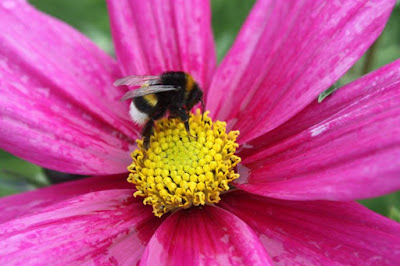Usually around this time of year in the garden I start thinking about what I wish I had done back in the spring. This is a great time to look around the yard and garden and begin making a plan for next year. Here in the south it allows you to take advantage of beautiful upcoming fall days to get the laying out and soil prep done.
Did you know digging in the soil can make you happier?
In a previous post I recommended planting a pollinator garden as another way to help our buzzing friends. If that's how you choose to be part of the solution you may be wondering what to plant that would most benefit the bees in your area. Here are some tips to help you get started once you have decided to make part of your yard, garden, or balcony a friendlier space for bees. Read about a day in a bee's life.
What to Plant
1. Plant colorful showy flowers. Bees are attracted to flowers with bright colors, particularly those in the blue violet range of the color wheel, along with white and yellow. They don't see red but plant those if you like for the butterflies and hummingbirds. Good examples are bee balm and Russian sage
2. Plant flowers that have one large blossom so that the hefty bumblebee can land on it securely. Think of sunflowers, zinnias, rudbekia. And plants that have tiny flowers for small bees. I like lamb's ear and salvia.
3. Plant plants that have hollow stems. Many varieties of native bees are solitary and nest in holes in the ground or in hollow stems of plants. All of the brambly canes like raspberry and blackberry are wonderful choices along with many types of ornamental grasses.
4. Plant types of flowers in big patches. This helps increase the bees' foraging efficiency.
5. Use low maintenance plants. The less we disturb a pollinator garden the better. This is not the place for plants that need deadheading and pruning. My favorites are bee balm, coreopsis, and many types of herbs like oregano.
6. Plant for consistent bloom. As soon as bees emerge in the spring they need nectar. After the big blooming season of spring and early there can be a dearth of flowering plants. Add things that bloom in late summer and early fall. Where I live narcissus, forsythia, and apples bloom very early. My absolute favorite for late summer to early fall are garlic chives which have white blossoms and do a wonderful job of providing nectar in that late summer dearth.
7. Plant flowers that have single blossoms. Many of the big showy double blossomed hybrids cultivated for enjoyment in the garden have little or no nectar for bees.
Other tips
8. Garden, don't landscape. Don't mulch or use weed barrier everywhere. 70 % of native bees nest underground.
9. Don't use chemicals. Even if you end up with a few weeds it's okay, they are bee friendly. Bees actually suffer when weeds are completely eradicated.
10. Leave stalks standing overwinter. For those bees that like to nest in hollow stemmed plants it's important to leave them a place to hibernate and nest next spring.
With the loss of native habitat to bees happening all over the world it is more important than ever to garden with them in mind. Planting one or all of these plants is a great way to help them in their time of need whether you are doing it in a spacious backyard or in a container on your apartment balcony, every pollinator friendly plant matters now.
Now when those garden catalogs start showing up next January you'll know what to do!
Now when those garden catalogs start showing up next January you'll know what to do!





ReplyDeleteThis page certainly has all of the info I wanted about this subject and didn't know who to ask. netflix login
Glad it helped!
Delete